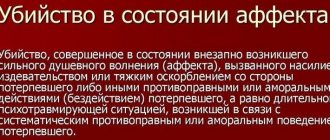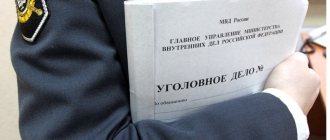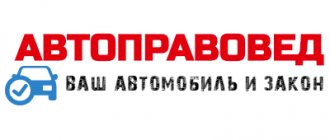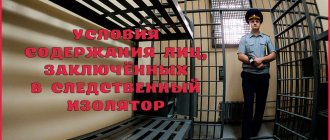In order to verify and clarify data relevant to a criminal case, the investigator has the right to conduct an investigative experiment by reproducing actions, as well as the situation or other circumstances of a certain event. At the same time, the possibility of perceiving any facts, performing certain actions, the occurrence of any event is checked, and the sequence of the event and the mechanism for the formation of traces are identified. An investigative experiment is permitted if there is no danger to the health of the persons participating in it.
What is an investigative experiment and what are its goals?
During the investigation, there is often a need to check certain circumstances or phenomena in the case under conditions close to reality.
Here are some examples of investigative experiments:
- could the citizen hear or see something about the offense from the place where he was at that time;
- is it possible to enter the scene of the theft;
- is it possible to transport goods by the method specified by the person in a car of a certain brand, etc.
This procedure is regulated by Art. 181 of the Code of Criminal Procedure of the Russian Federation, and its goals are as follows:
- establishing the truth of what happened;
- comparison of facial testimony with what took place in reality;
- study of a citizen's actions during a crime.
Article 187 of the Code of Criminal Procedure of the Russian Federation. Place and time of interrogation
- The interrogation is carried out at the place where the preliminary investigation was conducted. The investigator has the right, if he deems it necessary, to conduct an interrogation at the location of the person being interrogated.
- The interrogation cannot last continuously for more than 4 hours.
- Continuation of the interrogation is allowed after a break of at least one hour for rest and eating, and the total duration of the interrogation during the day should not exceed 8 hours.
- If there are medical indications, the duration of the interrogation is determined based on the doctor’s opinion.
Types of investigative experiments
Two main groups:
- Reproduction of facial actions.
- Reconstruction of events that do not depend on the citizen.
The first group includes the following investigative experiments:
- the perception of a fact in the conditions that the person himself spoke about (for example, whether he could hear something from a certain place);
- commission of an action (whether it was possible to enter the premises the way the alleged thief did);
- reproduction of actions that require certain skills (would it be possible to tie a knot in the same way, etc.).
The second group consists of the following:
- the possibility of the occurrence of any phenomenon or incident (can sediment form in the drink over a certain period of time, etc.);
- the mechanism of the entire event or its individual stages (could the engine in the car stop working for one reason or another);
- the process of creating traces (for example, whether the seized objects could be used to commit an offense).
III. Article 19.7 of the Code of Administrative Offenses of the Russian Federation
Often, in their requests “for information,” police officers point out the responsibility provided for in Article 19.7 of the Code of Administrative Offenses of the Russian Federation - for failure to provide information (information). This norm establishes liability - for citizens - from one hundred to three hundred rubles; for legal entities - from three thousand to five thousand rubles, for “failure to submit or untimely submission to a state body (official) of information (information), the submission of which is provided for by law and is necessary for this body (official) to carry out its legal activities, as well as submission to the state body (official) of such information (information) incompletely or in a distorted form.”
In accordance with the previously effective Law “On the Police,” police officers were given the right to:
- receive from citizens and officials the necessary explanations, information, certificates, documents and copies of them (clause 4 of article 11 of the Law “On the Police”);
- receive information free of charge from organizations and citizens, except in cases where the law establishes a special procedure for obtaining relevant information (clause 30 of article 11 of the Law “On the Police”).
At the same time, according to Article 23 of the Law “On the Police”, the legal demands of a police officer were mandatory for execution by citizens and officials.
Thus, the police’s right to receive information from organizations and citizens (clause 30 of Article 11 of the Law “On the Police”) did not give rise to a similar obligation for organizations. And the general director, as well as any other employee of the company, as a citizen, did not have the authority to provide documentation related to the activities of the organization and had the right not to give explanations on the basis of Art. 51 of the Constitution of the Russian Federation.
In this connection, there was no liability for failure to provide information and documents for organizations and employees.
Now, failure to comply with the legal requirements of a police officer, provided for in paragraphs. 4 and 17 art. 13 of the Law “On Police” entail liability under Article 19.7. Code of Administrative Offenses of the Russian Federation. According to Part 4 of Article 13 of the Law “On the Police”, “The requirements (requests, submissions, orders) of authorized police officials, provided for in paragraphs 4...17...Part 1 of Article 13 of the Law “On the Police”, are mandatory for execution... by organizations... and other persons within the time limits established in the request, but no later than one month from the date of delivery.” As already mentioned, article 19.7. The Code of Administrative Offenses of the Russian Federation, for failure to comply with these requirements, sets the following fine: for citizens - from one hundred to three hundred rubles; for legal entities - from three to five thousand rubles.
Brief content of the article. 181 Code of Criminal Procedure of the Russian Federation with comments
It contains the definition of the term, which we have already discussed above, as well as its types (we also talked about them in the previous section). The investigator is responsible for carrying out the investigative experiment, and he is obliged to maintain safety for all participants in the process.
Throughout the entire procedure, it is allowed to use the same actions, but with some changes in the parameters. The main goal is to recreate the necessary conditions for the entire process to take place.
Mandatory participants in the experiment are witnesses, the investigator, the citizen himself and technical specialists, but it is carried out precisely on the initiative of an employee of the investigative agency. This is the main difference between checking testimony on the spot and an investigative experiment.
Judicial practice under Article 177 of the Code of Criminal Procedure of the Russian Federation
Russian legal proceedings in criminal cases consist not only of the direct consideration of the case by the court, but also of the pre-trial stages of collecting and summarizing evidence.
The ideal (from the point of view of the process) is physical evidence, since it does not require interpretation and correlation with other evidence. The main source of physical evidence in any criminal case is the results of the examination.
Because of this, judicial practice under Art. 177 of the Code of Criminal Procedure has a number of specific features:
- participants in the process cannot appeal the actions of the investigator at the stage of the preliminary investigation, since the inspection, with rare exceptions, does not require a separate resolution;
- any verdict is based on an assessment of physical evidence, therefore, an appeal against the legality of inspections performed during the investigation of a case takes on the form of arguments in appeals and cassation complaints of the convicted;
- on the basis of the investigator’s failure to comply with procedural requirements during the inspection, the participants in the process may file a motion to exclude material evidence as obtained by unacceptable methods;
- When investigating economic crimes, organizations in whose premises a search or seizure of documents and other items were carried out have the opportunity to appeal the actions of the investigator in accordance with Art. 125 Code of Criminal Procedure of the Russian Federation.
When considering complaints about the legality of inspections and seizures, the courts proceed from the criterion of the sufficiency of the actions taken by the investigator to form a circle of evidence in a particular case. If the permissible limits are exceeded, the decision is canceled in whole or in part, and the illegally seized is returned.
When considering appeals based on the illegality of investigative actions taken during the collection of evidence, the courts proceed from the inadmissibility of re-evaluating evidence in the case under consideration unless absolutely necessary.
Who conducts
Potential offenders, victims of crimes or other participants in the proceedings can apply for this procedure, but only the investigator has the right to conduct the experiment itself.
Only an employee of the investigative agency is able to assess whether the entire procedure is being carried out objectively and correctly. Specialists and witnesses can also participate in it. Inviting the latter is a must. If the process proceeds without them, it will not be considered legal.
Confrontation
This is a special type of interrogation aimed at eliminating contradictions in testimony. How does it go? Two citizens are interrogated in turn, whose testimony contradicts each other. There are also rules. Those being interrogated can ask each other questions, refute or agree with what the second participant said, and provide additional information.
The accused and the suspect may refuse in writing to testify in a confrontation. But this does not cancel their participation in the event.
Tactics
The tactics of an investigative experiment are understood as those actions taken by the investigator to conduct the process. This ensures its legality and validity.
Principles of the procedure:
- the experiment is carried out in conditions that are as similar as possible to those that existed during the incident itself (this may be the scene of a crime or a reconstructed situation);
- To do this, several actions take place in a logical sequence;
- repeating them is not prohibited; on the contrary, it helps to establish real events.
The whole process is divided into three stages:
- preparatory;
- worker;
- final.
Preparation
Conducting an investigative experiment is permitted only after all preparatory processes have been followed.
Preparation takes place before the entire group leaves for the experiment site. The investigator determines who will participate in the procedure, what technical means will be used, and what his goals and objectives are. He draws up a plan for the event, ensures the arrival of all participants and orders transport.
After the participants arrive at the scene of the incident, the situation itself is prepared and a check is made to see whether everything has been taken into account and to what extent all participants are aware of their rights. They are also warned about the liability arising under Art. 307 and 308 of the Criminal Code of the Russian Federation.
Production
It begins after the citizen, in respect of whom the experiment is being conducted, testifies about the situation and actions he performed at the scene of the incident. The investigator then asks him to show what he was doing at each specific time period.
At the same time, he should not forget about the psychology of the investigative experiment, since it can be difficult for victims to remember traumatic events.
The investigator has the right to ask to repeat the sequence of events and make any changes during their implementation. If the need arises, he consults with specialists.
If actions are performed by different people, each of them takes turns showing what they did. If one of them is missing, actions are performed by those who are most similar to these citizens.
Final stage and evaluation
During the last stage, the investigative experiment protocol form is filled out. It is accompanied by recordings of cameras installed during the experiment.
After the end of the process, the investigative experiment is carefully checked and evaluated.
Evaluation of the experiment includes the following steps:
- checking its goals, objectives, content and sequence of actions;
- comparison of the conditions under which the experiment was carried out with those that took place in reality;
- evaluation of tactical methods;
- comparison of the results obtained with other evidence in the case.
Another comment on Article 178 of the Code of Criminal Procedure of the Russian Federation
1. The article under comment regulates not only the examination of the corpse, but also its exhumation (removal from official burial places).
2. In some cases, the examination of the corpse is an independent and separate investigative action, in others it is an organic part of the inspection of the crime scene and is carried out either at the place of discovery or outside it. In the latter case, this is an independent investigative action, the production of which is recorded in a special protocol. The results of the examination of the corpse at the scene of the incident are recorded in the protocol of the inspection of the scene of the incident.
3. The participation of a forensic expert (if not possible, a doctor) in examining the corpse is mandatory. An external examination of a corpse does not replace or exclude the subsequent appointment and conduct of a forensic medical examination.
4. During an external examination of the corpse, the following is established: the location of the corpse at the scene of the incident; his posture, gender and approximate age, presence of injuries and marks; the appearance of clothes and shoes on the corpse; nature of damage to clothing; the presence of traces, stains, or special marks on it. During the examination of the corpse, tools and objects located on the corpse, objects and documents found in the pockets of clothing, etc. are subject to inspection and examination.
5. Part 2 of the commented article establishes mandatory photography and fingerprinting of unidentified corpses. In addition, their cremation is prohibited.
6. If it is necessary to remove a corpse from a burial place, it is mandatory to issue a resolution regarding this and notify the relatives of the deceased. If relatives object to exhumation, permission to carry out it can only be given by the court (see appendices 42, 43 to article 476).
7. The resolution on the exhumation of a corpse shall indicate whose corpse is to be exhumed, where it is buried, and for what purposes this action is necessary. Exhumation is carried out if it is necessary: a) to inspect (including repeated) the buried corpse; b) present the corpse for identification; c) carry out an examination (including repeated or additional).
The decree on exhumation is mandatory for the administration of the burial site.
8. Regarding the persons involved in removing the corpse from the burial site and examining it, see Part 1 of the commented article.
9. Presentation for identification of the corpse and its examination can be carried out at the place of its extraction. In this case, the data obtained as a result of these investigative actions, as well as their sequence, are entered into the general protocol for the exhumation of the corpse (see Appendix 44 to Article 476).
10. If the exhumed corpse was presented for identification or was examined in another place, a special protocol is drawn up about the actions taken.
Investigative experiment protocol
It is not much different from those that are formalized during other investigative actions.
Its structure is as follows:
- goals and objectives of the experiment;
- list of its participants;
- information about the investigator who conducted it;
- a description of the environment in which the procedure took place;
- how the participants were positioned before the start of the experiment;
- a list of all actions performed by a citizen and the results that were obtained;
- list of technical means used;
- a note indicating any comments regarding the procedure;
- signatures of participants.
Comments and legal advice on Art. 177 Code of Criminal Procedure of the Russian Federation
The work of lawyers performing the functions of defense attorneys in criminal proceedings often takes the form of searching and identifying the slightest errors in the investigation. Knowledge of the procedure for carrying out various procedural actions allows one to significantly reduce the evidence base even at the stage of preliminary investigation.
Practicing lawyers, summarizing their own experience and the experience of their colleagues, name several common violations when conducting inspections of objects:
- The investigator did not give the opportunity to familiarize himself with the resolution before the start of the investigative action.
- The inspection was carried out in the absence of witnesses, when their presence is required.
- The protocol does not contain any indication of consent to conduct an inspection of the home, even if some of the residents do not deny verbal consent to its conduct.
- The seizure of objects was carried out in the absence of witnesses and without photo or video recording of the process itself.
- The protocol does not contain an exhaustive list of individualizing characteristics of the seized items.
- There is no seal or signature on the packaging of the seized items.
- Conducted as an illegal search.
- Executed before receiving a court decision.
- Items not relevant to the resolution of the case were confiscated.
- Indication as a justification for the seizure of items of circumstances that do not correspond to actual realities.
Any violation during the inspection is of great importance, especially if there is only one physical evidence. Investigators, trying to meet deadlines or anticipating the possibility of destruction of evidence by a criminal, make minor and sometimes major mistakes. It is on such investigative errors that the line of defense is often built.
Article 193 of the Code of Criminal Procedure of the Russian Federation. Presentation for identification
- The investigator may present a person or object to a witness, victim, suspect or accused for identification. A corpse may also be presented for identification.
- Those identifying are preliminarily interrogated about the circumstances under which they saw the person or object presented for identification, as well as about the signs and features by which they can identify it.
- A person or object cannot be identified again by the same identifier and based on the same characteristics.
- The person is presented for identification along with other persons who, if possible, are similar in appearance to him. The total number of persons presented for identification must be at least three. This rule does not apply to identifying a corpse. Before the identification begins, the person being identified is asked to take any place among the persons presented, about which a corresponding entry is made in the identification protocol.
- If it is impossible to present a person, identification can be carried out using his photograph, presented simultaneously with photographs of other persons who are externally similar to the person being identified. The number of photographs must be at least three.
- The object is presented for identification in a group of homogeneous objects in the amount of at least three. If it is impossible to present an object, its identification is carried out in the manner established by part five of this article.
- If the identifying person pointed to one of the persons or one of the objects presented to him, then the identifying person is asked to explain by what signs or features he identified this person or object. Leading questions are not acceptable.
- In order to ensure the safety of the identifier, the presentation of a person for identification, by decision of the investigator, can be carried out in conditions that exclude visual observation of the identifier by the identifiable. In this case, the witnesses are at the location of the identifying person.
- Upon completion of the identification, a protocol is drawn up in accordance with Articles 166 and 167 of this Code. The protocol indicates the conditions, the results of the identification and, if possible, the explanations of the identifying officer are stated verbatim. If the presentation of a person for identification was carried out under conditions that precluded visual observation of the person being identified, this is also noted in the protocol.
Article 188 of the Code of Criminal Procedure of the Russian Federation. Procedure for calling for questioning
- A witness or victim is summoned for questioning by a summons, which indicates who is summoned and in what capacity, to whom and at what address, the date and time of appearance for questioning, as well as the consequences of failure to appear without good reason.
- The subpoena is handed to the person summoned for questioning against a signature or transmitted via communication means. In the event of the temporary absence of a person summoned for interrogation, a subpoena is given to an adult member of his family or transferred to the administration at his place of work or, on behalf of the investigator, to other persons and organizations that are obliged to hand over the subpoena to the person summoned for interrogation.
- A person summoned for questioning must appear on time or notify the investigator in advance of the reasons for failure to appear. In case of failure to appear without good reason, a person summoned for questioning may be brought in or other procedural coercive measures may be applied to him, provided for in Article 111 of this Code.
- A person under the age of sixteen is summoned for questioning through his legal representatives or through the administration at his place of work or study. A different procedure for calling for questioning is allowed only if it is caused by the circumstances of the criminal case.
- The serviceman is summoned for questioning through the command of the military unit.







